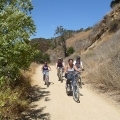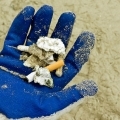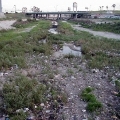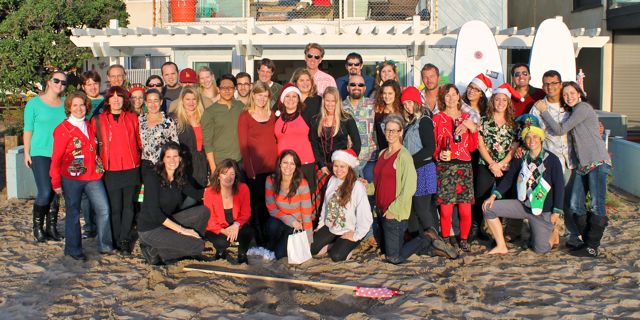As representatives of Heal the Bay, we often get asked: “Is the bay healed yet?” People know we’ve been at this a long time (more than 25 years). While the answer is a qualified “yes,” we still work every day to fulfill our mission to make southern California’s coastal waters and watersheds, including Santa Monica Bay safe, healthy and clean. Our tools? Science, education, community action and advocacy.
Each year we discuss where we’ve been, where we’re headed and how we’re going to get there. It’s a valuable process requiring that we all know what our HtB colleagues are up to: whether we’re teaching school kids at our Aquarium, coordinating our next advocacy campaign or analyzing water samples in Malibu Creek.
Here’s what we came up with for our goals of 2013:
Science
Marine Protected Areas and Fisheries
In 2013, we plan to continue to build our MPA Watch program. We will review data collected by MPA Watch volunteers and interns, and share it with management, enforcement, and other monitoring agencies to help understand and evaluate how local Marine Protected Areas (MPAs) are being used. We also plan to inform and evaluate the development of fisheries management plans for key southern California fisheries, including spiny lobster. Additionally, in 2013, we will work with local and statewide partners to advance the statewide sustainable seafood policy developed by the Ocean Protection Council (with Heal the Bay’s involvement) and local efforts to promote sustainable seafood. On the education front, we are playing a leadership role in creating new MPA curriculum for teachers with the Southern California Aquarium Collaborative.
Stream Team
Heal the Bay will continue to develop our Stream Team program. We plan to begin evaluating watershed impacts associated with agricultural development in the Santa Monica Mountains, including vineyards. Additionally, we hope to inspire residents and recreationists in the watershed to become Creek Stewards, and help scout for watershed health impacts throughout these mountains.

Malibu Creek Watershed
We will educate local partner groups and management agencies about the findings of Heal the Bay’s State of the Malibu Creek Watershed report. We will also work with watershed partners and policymakers to prioritize and implement recommendations detailed in the report aimed at improving local stream and watershed health.
Predicting Beach Water Quality
Heal the Bay will continue our partnership with Stanford University in developing a predictive beach water quality models. The models will use oceanic and atmospheric factors (i.e. tides, waves, temperature, wind direction etc.) as inputs to forecast indicator bacteria concentrations at beaches, as means of providing early “nowcast” warnings of human health risks (our current methods take 18-24 hours to process, leaving the public with day-old water quality information). We plan to develop simple models for 25 different California beaches that will rapidly “predict” when beaches are in or out of compliance with water quality standards. Additionally, these models will be helpful in identifying and prioritizing beach cleanup and abatement priorities.
Education
Youth Summits
To take student learning beyond the classroom into community action and civic engagement, Heal the Bay will organize more youth summits. Students learn how to protect what they love through adjusting their own behavior, speaking publicly to businesses and governments and educating others in their local communities. This year we will focus on scheduling these events quarterly, formalizing their structure, and expanding their reach throughout Los Angeles County high schools. 
Teacher Opportunities
Heal the Bay will expand our teacher education and professional development opportunities in 2013. New workshops and field experiences will be offered to help increase teacher expertise in teaching environmental principles and concepts, marine and watershed science knowledge, and best practices for melding field and laboratory activities into their own classroom curricula.
Santa Monica Pier Aquarium
To further educate the 75,000-80,000 annual visitors to the Aquarium about water conservation, we plan to overhaul the Green Room, named after Heal the Bay’s founding president Dorothy Green, with a new exhibit in her honor. The education room will include interactive, bilingual exhibits on watershed education and the urban water cycle, as well as a space dedicated to Dorothy’s accomplishments and inspirational vision.
Classroom Enrichment
In 2013, we’ll expand our environmental education outreach to more low-income communities and to a wider range of age groups. Through our partnership with the Discovery by Nature program, we’ll be able to reach classrooms in underserved communities, where public education in the sciences — as well as field trip funding — are limited.
Advocacy
A “Yes” for Clean Beaches
In the new year, Heal the Bay will mobilize support for the Clean Waters, Clean Beaches funding measure, which will drive an extensive and multi-faceted water quality clean up and conservation program in Los Angeles County. The proposed measure would address contaminated drinking water, polluted stormwater runoff as well as toxins and trash in the Los Angeles and San Gabriel rivers, among other challenges.
Plastic Bag Bans
In 2013, we will take a leadership role in advocating for a strong single-use bag ordinance for the City of Los Angeles that is consistent with several other policies adopted by local governments in the area. We will work with partner groups and City Council offices to conduct outreach to the community about the pending ordinance, and ensure that a final policy is adopted that eliminates single-use plastic bag usage in the City at grocery stores, pharmacies, and convenience stores, and greatly reduces paper bag distribution from these locations.
Community Action

Zero Waste Cleanups
In 2013, Heal the Bay plans to run all Nothin’ But Sand monthly beach cleanups as Zero Waste events. Building upon the success of the 2012 Zero Waste cleanups in October and November, we shall focus this year on not generating excessive waste in the process of performing large-scale public volunteer events. The hope is that the public will witness our commitment to practicing what we advocate, by going reusable and minimizing trash.
Compton Creek

Heal the Bay, in partnership with the U.S. Army Corps of Engineers and the Goldhirsh Foundation, will complete a project to build trash capture devices in the concrete portion of Compton Creek, just upstream of the earthen-bottom, riparian section. Compton Creek is the last major tributary that feeds into the Los Angeles River before it ultimately reaches the ocean in Long Beach. The devices ‑- adjustable metal racks that will be bolted into the channel bottom — will capture trash from dry weather urban runoff and low volume producing storm events and go a long way toward improving water quality.
A Park in South L.A.
Heal the Bay is partnering with Wisdom Academy for Young Scientists (WAYS) Charter School to complete the construction of the WAYS Reading & Fitness Park on the site of 4,000-square feet of unused City land in 2013. This park, located at the intersection of McKinley Avenue and 87th Street in South Los Angeles, will be on the leading edge of green technology, recycling street water to irrigate its own landscape.
Read more about Heal the Bay and how we work to fulfill our mission.



 The Hawaii survey turned up masses of typical ocean garbage, including fishing nets and traps, Mallos said, noting the irony of also finding a “Heal the Bay” trashcan.
The Hawaii survey turned up masses of typical ocean garbage, including fishing nets and traps, Mallos said, noting the irony of also finding a “Heal the Bay” trashcan.
